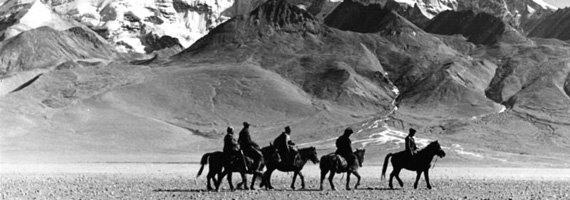
A caravan crossing the Old Silk Route (Attribution: Bundesarchiv Bild 135-S-10-04-32)
The Silk Route or Silk Road refers to a network of ancient trade routes connecting Asia, Europe and Africa. Extending more than 6,500 kms, the Silk Route was majorly used to transport Chinese Silk to Europe through Central Asia from 2nd Century BC. However, many trade routes (both sea and land routes) existed in much earlier times that connected the main Silk Route and traded in different commodities ranging from salt to gold. Silk Route’s greatest contribution to world history was not mere trading of few commodities but exchange of ideas, art and science between Asia, Europe and Africa. It was the world’s first information superhighway.
Greek art from Europe flowed into India whereas Buddhism from India reached out to the world through the Silk Route. Chinese travelers like Fa Hein (Faxian), Hiuen Tsang (Xuanxang) and others visited India through these ancient routes and Marco Polo witnessed the grandeur of the Chinese civilization while traveling through the silk route. The Arabs took the knowledge of mathematics and medicine from India and China and worked on it to bring up new sciences like Algebra, which were adopted by Europe in due course. New cities and empires grew along the Silk Route and world power shifted from hand to hand. History of the world was re-shaped along this route and world population for the first time started exchanging ideas on a scale that was unheard of. The habits, cultures and livelihoods of the world population were influenced by knowledge and ideas brought from different lands. Obscure cities like Lhasa became the seat of religious power and emerged as one of the finest cities in the remotest corners of the Himalayas. The advent of Silk Route is one the most remarkable events in world history. Almost all Ancient Trade routes across Asia and Europe merged with the Silk Route at some point and the whole network of trade routes became the world’s first international cultural phenomenon.
The Silk Route in Sikkim
The Silk Route in Sikkim is an offshoot of an ancient trade route which came from Lhasa, crossing Chumbi Valley and passed through Nathula Pass and finally took the port of Tamralipta (present Tamluk in West Bengal). From Tamluk, this trade route took to the sea and reached Sri Lanka, Bali, Java and other parts of the Far East. We find the mention of Tamralipta as a busy sea-route on Bay of Bengal in Fa Hein’s accounts as early as 400 AD. This portion of the Old Silk route through Bhutan, East Sikkim and West Bengal was quite less travelled but is expected to have been discovered by traders as early as First Century AD. Most of the Mountain Passes in this region of the Eastern Himalayas are around 14,000 feet above sea-level and stays snow covered from November to April, which makes this route one of the most inhospitable regions on earth. The distance between Lhasa and Tamralipta through this nearly obscure part of the Ancient Silk Route was around 900 kms, which is significantly less than other seaports from Lhasa and this route was comparatively a safer land route option for the traders’ caravans.
Most popularly termed as the South West Silk Route, this is one of the most ancient parts of the route which connected the Yunan Province of China to Tibet and finally to India and as far as Afghanistan. Interestingly, silk was not the most treasured item traded in this part of the route – it was horses and tea, so the Chinese often referred this route as Dianzang Chama Gudao (ancient road of tea and horses between Yunnan, Tibet and India). Other important items traded in this route were sugar, salt, copper and cotton and unlike its counterparts in Central Asia, the caravans in this part of the South West Silk Route comprised horse caravans and not the Bactrian camel caravans.
There were further offshoots of this South West Silk Route from Lhasa and Lanzhou which crossed the Eastern Himalayas and reached Sikkim at different High altitude passes other than Nathu La like Jelep La and Dhonka La. All these routes converged at Eastern Sikkim and finally led to plains of Bengal from where they bifurcated to various sea ports and trade centers on coastal Bay of Bengal like Tamluk in India, and Wari-Bateshwar, Bhitagarh, Mahasthangarh, Bikrampur and Sonargaon in present Bangladesh. A section of the South West Silk Route crossed Lhasa and entered India through Nathu La from China whereas another section of the route crossed Burma (present Myanmar) and entered India through Assam (Kamrup) further to the sea ports of Bengal and present Bangladesh.
During recent times, this part of South West Silk Route through Nathu La was mostly operated by the Lhasa Newars for the last 400 years. The Lhasa Newars were influential expatriate traders from Kathmandu Valley who traded in Tibet for centuries. They traded between Tibet, Nepal and Gangetic plains of Eastern India over the Silk Road, and were a major cultural and economic bridge between Central Asia and South Asia. The Lhasa Newars rode their caravans over the Nathu La and Jelep La passes which were approached from Kalimpong in West Bengal and Gangtok in Sikkim. The Lhasa Newar trading ended after Nathu La was shut down by the Sino-Indian War in 1962.
Much of the modern history of the South West Silk Route through Sikkim would remain unfinished without the mention of Sir Francis Edward Younghusband – the famous British Explorer and Army officer. In 1904, Major Francis Younghusband led a successful mission through Nathu La to capture Lhasa. He travelled through much of present North Sikkim and East Sikkim’s Silk Route corridor to enter Tibet with his troops.
